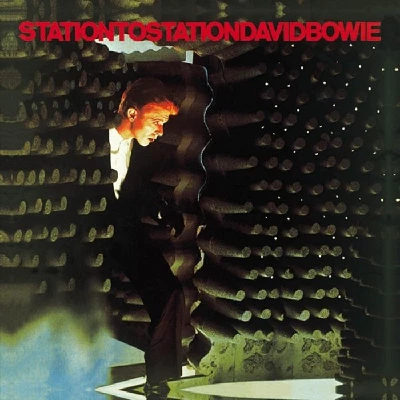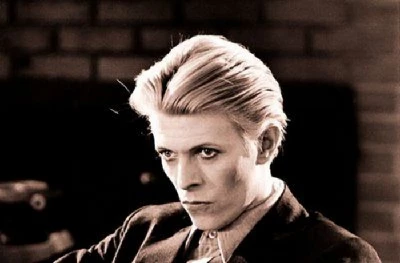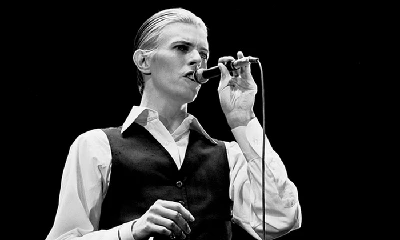published: 5 /
2 /
2016

In our 'Re:View' section, Richard Lewis looks at David Bowie’s tenth album, 'Station to Station', which released in 1976 marked another significant stylistic shift
Article
Released in January 1976, ‘Station to Station’ stands as one of David Bowie’s most fascinating albums, an LP that while containing several live staples and a huge hit in 'Golden Years' is one of the most lyrically intriguing of his career. Described by 'NME' scribes Roy Carr and Charles Shaar Murray as an LP that "effectively divides the '70s for David Bowie. It ties off the era of 'Ziggy Stardust' and plastic soul, and introduces the first taste of the new music that was to follow with 'Low’", the disc acts as a resume of his career so far and provides a foreshadowing of what was to follow.
Co-produced by Bowie and ‘Young Americans’ helmer Harry Maslin, the LP retains many of the musicians who had forged the previous year’s album. Crucially the present LP cemented the core line-up of drummer Dennis Davis, rhythm guitarist Carlos Alomar and bassist George Murray who would work with Bowie up until 1980 album 'Scary Monsters'.
Supplementing these players with lead guitarist Earl Slick, pianist Roy Bittan (now one of the longest serving member of Bruce Springsteen’s the E Street Band) and long-serving backing vocalist Warren Peace, the set was recorded in Los Angeles over two months in late 1975.
As Maslin stated in an interview with now defunct US magazine 'Circus' at the time of the LP's release, "There was no specific sound in mind. I don't think he had any specific direction as far as whether it should be R&B, or more English-sounding, or more commercial or less commercial."
Paradoxically for an album considered to be ‘European’, the sessions took place in Cherokee Studios, Hollywood. The LP was recorded at a time when Bowie’s drug consumption, specifically cocaine was at its peak, with the singer later claiming to be unable to recall virtually anything of the sessions.
Its title partially inspired by the singer’s 1973-76 live schedule, undertaken largely by train due to a fear of flying, the moniker also hints at the Stations of the Cross, a subject covered in the epic title track.
The album proved to be a major artistic development for Bowie in that it introduced the singer’s new persona the Thin White Duke, a detached, occasionally irascible aristocrat that represented Bowie’s final alter-ego following on from Major Tom, Ziggy Stardust and Aladdin Sane.
Inspired by groundbreaking German electronic pioneers Kraftwerk and Neu! the former’s track 'Radioactivity' was the entrance music for Bowie’s 'Isolar' 1976 World Tour, where the singer debuted the Thin White Duke onstage. "My favourite group is a German band called Kraftwerk. It plays noise music to ‘increase productivity’," Bowie explained when interviewed by music writer Cameron Crowe for 'Playboy' in September 1976.
Wrapped in a stark monochrome cover that features a still from 'The Man Who Fell to Earth' (1976), it shows Bowie as the film’s lead character Thomas Jerome Newton, entering the space capsule that will return him to his home planet. The role would have a profound impact on Bowie’s psyche, as director Nicholas Roeg cautioned him the character would be difficult to "shake off"’, something Bowie later conceded in succeeding years.
Opening with the exhilarating title track which shifts from a slow avant garde piece underpinned by offbeat piano chords onto its barnstorming midsection where the seven piece band gloriously take flight, the ten minute cut is the longest track in Bowie’s canon.
Informed by a frankly bewildering selection of literature, the track's lyrics encompasses German philosopher Friedrich Nietzsche, English occultist Aleister Crowley along with counterculture totem 'The Morning of the Magicians' (1963) and 1973 Trevor Ravenscroft novel, ‘The Spear of Destiny’.
The themes explored in the song picked up the baton from earlier Bowie tracks as music writer Ian MacDonald highlighted, including ‘The Supermen’ (‘The Man Who Sold the World’, 1970), ‘Big Brother’ (‘Diamond Dogs’, 1974) plus ‘Quicksand’ and ‘Oh! You Pretty Things’ from his 1971 set ‘Hunky Dory’.
Featured on the back cover of the 1999 CD reissue of the album Bowie is a drawing 'The Kabbalistic Tree of Life'. The impact of these themes on Bowie can be measured by the inclusion in his final ever video, the valedictory swan song of ‘Lazarus’, which has scenes of the singer in a diagonally striped suit that refers back to the 1976 photo shoot. The opening lines of the second verse "Here are we/One magical movement/From Kether to Malkuth" was hailed by Israel's oldest daily newspaper 'Haaretz' in 2010 as "perhaps the only usage of kabbalistic terminology in Hebrew ever by a major international pop singer,"
Due to his colossal drug intake at this time, Bowie’s addled sensibilities had seen him make incautious remarks about fascism in interviews, something he strenuously denounced following a concerted clean-up and his experiences in Berlin the following year.
Harking back to the style of the previous LP, one of the singer’s most beloved songs 'Golden Years', supplied the disc’s lead single. An excellent double feature with US number one single ‘Fame’, Bowie broke further ground by appearing on legendary US TV music show 'Soul Train' to perform both tracks, becoming one of the first white acts to appear on the US TV institution.
Taken by some critics to be nearest thing to a hymn written by the singer, 'Word On A Wing' was written during the depths of drug-induced despair, Bowie counteracting any evil spirits that may want to visit by wearing a silver crucifix at all times. Producer Harry Maslin interviewed by 'Circus' magazine on the song’s subject matter at the time said, "I don't think he's into any specific kind of religion or philosophy. He's interested in them all, and mysticism, but I think David's too intelligent to try to follow one philosophy."
Pulled from the set as the second single, sci-fi nightmare 'TVC15' has a demon television set that sees the narrator’s girlfriend disappear into the screen, and was inspired by a drug-induced hallucination. It evokes the Thomas Jerome Newton character from 'The Man Who Fell to Earth' near-comatose in front of his myriad TV screens.
A track that acts as continuation of the soul and R&B idioms of 'Young Americans, 'Stay' is driven by a sinewy funk supplied by Carlos Alomar and is given a tougher edge than it may have received on the previous LP.
Earl Slick, one of Bowie’s longest serving sidemen who returned to work with the singer in the early 2000s, firmly puts his stamp on the cut, brilliantly twisting the song out of shape in a dazzling display of instinctual playing that saw the track become a long-term live favourite.
Adding to the prominence in Bowie’s catalogue, both this and 'TVC15' later appeared in a concert sequence featured in cult movie ‘Christiane F. – We Children from Bahnhof Zoo’ which surveyed the grim wreckage of the drugs and vice scene around the then notorious ‘Zoo Station’ in late 1970's West Berlin.
Plaintive romantic ballad, 'Wild is the Wind', a cover of the Johnny Mathis song ad from the 1957 film of the same name, concludes the LP with one of the most ostensibly straightforward cuts in Bowie’s catalogue. Proof of the song’s endurance in his live set. The track was opening cut at Bowie’s triumphant 2000 headline slot at Glastonbury (four of the tracks from the present LP were included in the setlist).
Unlike its defiantly avant-garde successor 'Low', 'Station to Station' was mixed as writer Ian MacDonald stated "big", the gloss lending the track's greater commercial appeal. An LP where all of the tracks found their way into live setlists over the ensuing decades and charting at a (then) career best high of number three in the US, 'Station to Station' remains one of Bowie’s most mysterious albums, deriving its potent energy from trying circumstances and signposting many of the themes the singer would explore for the remainder of his career.
Track Listing:-
Band Links:-
http://davidbowie.com/blackstar/
https://www.facebook.com/davidbowie
https://twitter.com/davidbowiereal
https://www.youtube.com/user/DavidBowi
Picture Gallery:-

